Top tips to apply in training your dog
How to train your pet

1. Use fantastic reinforcement techniques
Almost all vets agree that positive reinforcement training is the most advantageous technique of canine training. Positive reinforcement training essentially focuses on profitable your pet for desirable behavior, instead than punishing bad behavior.
Whenever your dog demonstrates good behavior and responds positively to your commands, reward them! By beneficial exact behavior, you’re reinforcing the association between desirable behavior and properly things.
It’s additionally vital to make positive you’re no longer inadvertently beneficial undesirable behavior. For example, if your canine barks at you to play or jumps up to say hello, don’t acknowledge it or supply in, as this just reinforces the horrific behavior. Instead, wait until they’re calmer before giving them attention.
2. Find the proper reward.
Some puppies are food-motivated, and will reply very enthusiastically to any sort of fit for human consumption deal with as a reward. Others are pickier: often, soft, chewy treats are preferred to hard, crunchy ones.
Some dogs, however, just aren’t that involved in meals at all. If this is the case with your pup, strive experimenting with other rewards, like a speedy play session with a favourite toy, or even just masses of affection.
3. Consistency is key.
Being steady in your education is enormously important. This consists of consistency in how you’re coaching your dog—for example, usually the usage of the same word, and even the same kind of intonation, when asking them to do something.
Equally important is for all people in your household to be on the equal page. Dogs want consistency to analyze new habits, so if you never let the dog on the couch, however your companion does, your pup will just stop up confused.
4. Train little and often.
Short education classes repeated at some point of the day are a great deal extra positive than longer ones. The American Kennel Club recommends keeping classes to five minutes maximum; any longer and your canine may additionally emerge as distracted or frustrated.
Dogs additionally often warfare to generalize instructions to different locations or situations (i.e., appreciation that asking for a “sit” at home is the identical factor as a “sit” on a busy street), so it’s useful to repeat your coaching classes in more than one locations, with specific people and with various levels of distraction, so that your pup learns to respond efficiently to the identical command all the time.
5. Build up in stages.
Starting small can be helpful, specifically when it comes to more complex behaviors like “stay,” or with behavior amendment (when you’re attempting to get rid of unwanted behavior).
Try breaking behaviors down into smaller parts. For example, in the beginning, if you’re coaching “come,” praise and reward your dog when they take even one step in the direction of you. It’s much simpler to add on steps and construct up to the entire conduct as soon as your pup begins to get the dangle of it.
6. Make it fun.
Training ought to be fun, both for you and your dog! Always maintain it positive, and strive mixing things up to preserve it interesting, such as incorporating short play classes into your training in between repetitions.
You ought to also think about education your dog to do hints in addition to normal obedience training. As humans, we naturally respond greater enthusiastically to seeing a canine rolling over than we will to a simple historical sit—our dogs select up on that enthusiasm and end up loving to perform tricks for us!
It’s handy to get caught up in the stop purpose of training, however understand to reward your canine for any small improvement.
7. Praise the small things.
Remember to constantly praise your canine for any improvement, no matter how small. It’s effortless to get caught up in the stop purpose of training, however celebrating the little wins is simply as important, and will assist keep each you and your canine motivated.
8. Work training into daily life.
By making coaching section of your regular pet routine, it’s a lot less difficult to in shape in many small sessions. For example, ask your dog to sit or reply to any other command earlier than you provide them their dinner, take them out for a walk, or play with them.
9. Use your hands.
Much as we’d desire they could, puppies can’t understand language the same way we do. Many puppies reply better to hand signals than verbal commands, so try combining the two, or even commence with only hand alerts and add the verbal command later.
10. Consult a canine trainer or attend a education class.
If you’re struggling, don’t hesitate to contact a expert canine coach or be a part of a training class. Generally one of the quickest ways to get results, expert trainers have years of know-how they can use to assist you and your pup. They will have experienced many different types of problems in their career, so they must have thoughts on how to address any troubles you can also be facing.
When selecting a trainer, take your time to do a little research. Make sure they use effective reinforcement techniques, and read plenty of opinions or get references if you can.
We host regular domestic dog training instructions at Small Door – reach out to our group for greater details!





Comments
There are no comments for this story
Be the first to respond and start the conversation.